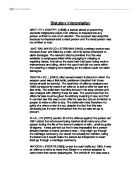" During the last 30 years there has been a shift away from the literalist approach to purposive methods of construction. When there is no obvious meaning of a statutory provision the modern emphasis is on a contextual approach designed to identify the purposes of a statute and to give effect to it." Lord Steyn. Discuss.
The process by which judges assign meanings to ambiguous words or phrases in statutes is called the interpretation of statutes. It is not the function of the courts to change or modify legislation. Parliament passes or authorises legislation and it is for the remainder of the legal system to apply the letter of law as appropriate.
Legislation is expressed in general terms. The wording of an Act of Parliament cannot deal with every possible connotation and is bound, on occasions, to be ambiguous and hard to understand when it is being applied to factual situations. For example Section 1 of the Theft Act 1968 states that theft is ' the dishonest appropriation of property belonging to another person with the intention of permanently depriving that person of it.' Nearly all of the words in the definition have to be interpreted in order to discover their true meaning in practice.
There are certain rules which are important for the construction of statutory interpretation. First is the literal rule; here the words of a piece of legislation should be given their ordinary and grammatical meaning. This rule can only be used if the wording in the statute is unambiguous. The court may use the Oxford English Dictionary to discover the usual and literal meaning of a particular word. If the word being examined is capable of more than one meaning the literal rule cannot be applied. A classic is Fisher v Bell (1961) where the prosecution of a shopkeeper under the Restriction of Offensive Weapons Act (1954) for offering for sale a prohibited weapon failed on the basis that the display of the weapon in the shopkeeper's window was not an "offer for sale", it was merely an "invitation to treat". Next is the golden rule; this rule is used where there is an ambiguity (i.e the word has more than one literal meaning). Under the golden rule the court adopt the least absurd meaning. In Coutts v IRC (1953) the court ruled that, where a statute brings about a ' startling and equitable result', the court should seek another interpretation in order to achieve better justice. Lastly – the mischief rule; if the words of a piece of legislation are uncertain or ambiguous the court will adopt the meaning most likely to give effect tot the intention of Parliament. This rule should only be applied if a literal interpretation does not produce a result. It is a last resort method as it allows the court to look outside the wording of the statute ( for example, at transcripts of parliamentary debates) to discover what parliament intended by the particular wording. It is called the mischief rule because it is supposed to take into account the mischief which the statute intended to remedy. For example in Corkery v Carpenter (1951) a bicycle was held to be a " carriage" for the purposes of the Licensing Act 1872 which provided that a person who was drunk while in charge of a carriage on the highway might be arrested without a warrant.







